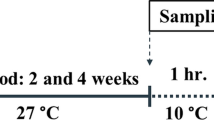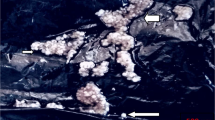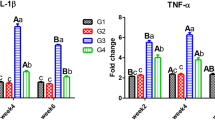Abstract
In order to investigate the relationships between levels of lipid peroxides (LPO), hydroxy lipids (L-OH) and of antioxidative enzymes in live fish, cultured cells from tilapia liver (Hepa-T1) were treated with oxidative stressors, 2,2′-azobios(2-amidino-propane) dihydrochloride (AAPH) and H2O2. By treating with 5 mM AAPH, LPO and L-OH of the cells significantly increased time-dependently. In particular, L-OH increased from 7.6±0.7 to 23.6±1.8 nmol/mg protein after 2 h of treatment, and synchronously the glutathione peroxidase (GPx) activity of the cells increased from 259±106 to 1970±135 mU/mg protein. In the case of H2O2, however, no elevation of L-OH was observed. In this case, catalase (CAT) and superoxide dismutase (SOD) activities increased time-dependently. Especially, after 2 h exposure, the CAT activity increased remarkably from 217±21 to 2510±120 mU/mg protein, though the GPx activity did not change significantly. These results suggest that the elevation of the L-OH level is closely associated with the elevation of GPx activity, but not with that of CAT or SOD. However, when vitamin E-enriched Hepa-T1 cells were treated with AAPH and H2O2, the production of LPO and L-OH was suppressed significantly. The findings suggest that vitamin E also plays an important role in the levels of the oxidation products in vivo.
Similar content being viewed by others
Change history
15 June 2018
"The original article was corrected. We had used a cell line, Hepa-T1, in the article as a cell line derived from tilapia liver. However, in April 2018 the provider of Hepa-T1, RIKEN BioResource Research Center (RIKEN BRC), informed us that Hepa-T1 was derived from eel but not tilapia. RIKEN BRC found this misidentification by DNA barcoding of the mitochondrial gene cytochrome c oxidase subunit 1 (COI) (Fig.��1) in a course of pursuing more precise method for species identification of cell lines (Almeida et al. 2016). RIKEN BRC suggested a possibility that Hepa-T1 was replaced with Hepa-E1 cell line which was derived from eel and was deposited from the same scientist. RIKEN BRC accepted the deposition of these two cell lines simultaneously in March 1995 and could not detect this misidentification by the method available at that time, i.e. isozyme analysis with lactate dehydrogenase and nucleotide phosphorylase."
15 June 2018
"The original article was corrected. We had used a cell line, Hepa-T1, in the article as a cell line derived from tilapia liver. However, in April 2018 the provider of Hepa-T1, RIKEN BioResource Research Center (RIKEN BRC), informed us that Hepa-T1 was derived from eel but not tilapia. RIKEN BRC found this misidentification by DNA barcoding of the mitochondrial gene cytochrome c oxidase subunit 1 (COI) (Fig.��1) in a course of pursuing more precise method for species identification of cell lines (Almeida et al. 2016). RIKEN BRC suggested a possibility that Hepa-T1 was replaced with Hepa-E1 cell line which was derived from eel and was deposited from the same scientist. RIKEN BRC accepted the deposition of these two cell lines simultaneously in March 1995 and could not detect this misidentification by the method available at that time, i.e. isozyme analysis with lactate dehydrogenase and nucleotide phosphorylase."
References
Christen Y. Oxidative stress and Alzheimer disease. Am. J. Clin. Nutr. 2000; 71: 621–629.
Yagi K. Lipid peroxides, free radicals, and diseases. In: Yagi K (ed.). Active Oxygen. Scientific Societies Press. Tokyo. 1993; 39–67.
Halliwell BB, Gutterridge JMC. Free Radicals in Biology and Medicine. Clarendon Press, Oxford. 1989.
Cross CE, Halliwell B, Borish ET, Pryor WA, Ames WA, Saul RL, MacCord JM, Harman D. Oxygen radicals and human diseases. Ann. Intern. Med. 1987; 107: 526–545.
Sevenian A, Muakkaah-Kelly SF, Montetruque S. The influence of phospholipase A2 glutathione peroxidase on the membrane lipid peroxidase. Arch. Biochem. Biophys. 1983; 223: 441–452.
Tanaka R, Higo Y, Murata H, Nakamura T. Accumulation of hydroxy lipids in live fish with oxidative stress. Fish. Sci. 1999; 65: 796–797.
Tanaka R, Higo Y, Shibata T, Suzuki N, Hatate H, Nagayama K, Nakamura T. Accumulation of hydroxy lipids in live fish infected with fish diseases. Aquaculture 2002; 211: 341–351.
Evans JJ, Shoemaker C, Klesius PH. Experimental Streptococcus iniae infection of hybrid striped bass (Morone chrysops X Morone saxatilis) and tilapia (Oreochromis niloticus) by nares inoculation. Aquaculture 2000; 189: 197–210.
Quabius ES, Balm DTN, Paul HM, Bonga W, Sjoerd E. The influence of polychlorinated biphenyl 126 on tilapia (Oreochromis mossambicus) liver. Comp. Biochem. Phys. Part A 1998; 120: 57–63.
Bainy ACD, Saito E, Carvalho PSM, Junqueira VBC. Oxidative stress in gill, erythrocytes, liver and kidney of Nile tilapia (Oreochromis niloticus) from a polluted site. Aqua. Toxicol. 1996; 34: 151–162.
Ursini F, Maiorino M, Brigelius-Flohé R, Aumann KD, Roveri A, Schomburg D, Flohé L. Diversity of glutathione peroxidases. Methods Enzymol. 1995; 252: 38–53.
Aebi H. Catalase in vitro. Methods Enzymol. 1984; 105: 121–126.
Garcia Ma. XU, Foote C, Saskia Es Devreotes PN, Alexander S, Alexander H. Differential developmental expression and cell type specificity of dictyostelium catalases and their response to oxidative stress and UV-light. Biochim. Biophy. Acta 2000; 1492: 295–310.
Oberley LW, Spitz DR. Assay of superoxide dismutase activity in tumor tissue. Methods Enzymol. 1984; 105: 457–464.
Nakamura T, Maeda H. A simple assay for hydroperoxides based on triphenylphosphine oxidation and high performance liquid chromatography. Lipids 1991; 26: 765–768.
William WC. The preparation of volatile derivatives of lipids. In: William WC (ed.) Lipid Analysis. Pergamon, Oxford. 1973; 88–89.
Zhang LP, Maiorino M, Roveri A, Ursini F. Phospholipid hydroperoxide glutathione peroxidase: specific activity in tissues of rats of different age and comparison with other glutathione peroxidases. Biochim. Biophy. Acta 1989; 1006: 140–143.
Imaia H, Sumia D, Sakamoto H, Hanamoto A, Arai M, Chiba N, Nakagawa Y. Overexpression of phospholipid hydroperoxide glutathione peroxidase suppressed cell death due to oxidative damage in rat basophile leukemia cells (RBL-2H3). Biochem. Biophys. Res. Comm 1996; 222: 432–438.
Sakai T, Murata H, Yamauchi K, Sekiya T, Ukawa M. Effect of dietary lipid peroxides contents on in vivo lipid peroxidation, alpha-tocopherol contents, and superoxide dismutase and glutathione peroxidase activities in the liver of yellowtail. Nippon Suisan Gakkaishi 1992; 58: 1483–1486.
Murata H, Sakai T, Yamauchi K, Ito, T, Tsuda T, Yoshida T, Fukudome M. In vivo lipid peroxidation levels and antioxidant activities of cultured and wild yellowtail. Fish. Sci. 1996; 62: 64–68.
Frankel EN. Biological systems. In: Frankel EN (ed). Lipid Oxidation. The Oily Press, Glasgow, 1998; 249–256.
Yoshikawa T. Free radical and elemination of active oxygen. In: Yoshikawa T (ed). Science of Free Radical. Kodansha, Tokyo. 1997; 45.
Niki E. Free radical initiators as source of water or lipid-soluble peroxyl radicals. Methods Enzymol. 1990; 186: 101–108.
Esterbauer H, Dieber-Rotheneder M, Striegl G, Waeg G. Role of vitamin E in preventing the oxidation of low density lipoproteine. Am. J. Clin. Nutr. 1991; 53: 314–321.
Burton GW, Traber MG. Vitamin E: antioxidant activity, biokinetics and bioavailability. Ann. Rev. Nutr. 1990; 10: 357–382.
Author information
Authors and Affiliations
Corresponding author
Rights and permissions
About this article
Cite this article
Tanaka, R., Hatate, H., Ito, M. et al. Elevation of lipid peroxide level and production of hydroxy lipids in cultured Hepa-T1 cells by oxidative stressors. Fish Sci 72, 665–672 (2006). https://doi.org/10.1111/j.1444-2906.2006.01197.x
Received:
Accepted:
Issue Date:
DOI: https://doi.org/10.1111/j.1444-2906.2006.01197.x




